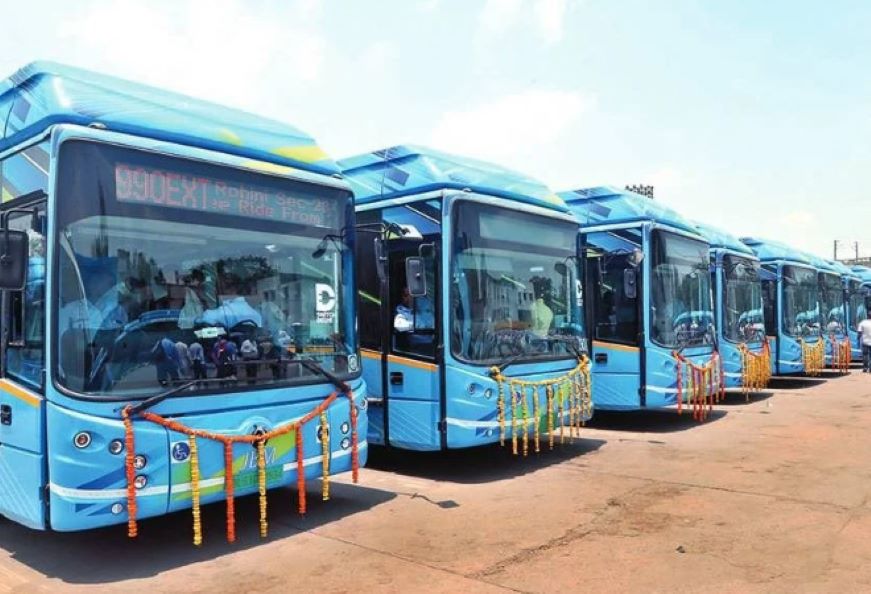-
CENTRES
Progammes & Centres
Location
The Delhi government is facing several challenges in shifting to electric buses. Overcoming these is important for controlling the recurring air pollution problem in the national capital.

The release of harmful pollutants from motor vehicles is a major problem in many Indian cities. The number of daily commuters is huge due to the city’s large population and areal extent, and the majority of the vehicles in use are powered by petrol, diesel, natural gas, or fossil fuels. Therefore, travel movements contribute significantly to air pollution. With increasing awareness of the harmful effects of poor air quality, efforts are being made by the government to promote and provide environment-friendly means of transportation.
At the all-India level, several emission-related interventions are noted in the urban transportation sector. This article restricts itself to the measures undertaken in Delhi for mitigating emissions from an important public transport mode, buses, and the challenges experienced in this endeavour.
The number of daily commuters is huge due to the city’s large population and areal extent, and the majority of the vehicles in use are powered by petrol, diesel, natural gas, or fossil fuels.
Delhi in 2023 is India’s most populous and largest city, spread over an area of 1,483 sq km. To meet citizen travel needs, four types of motorised public transport facilities have been provided by the government. These include metro rail, bus, taxi, and auto rickshaw. In addition, privately run taxis are available in abundance. The role of each of these modes is important as mentioned below.
With the expansion of the metro rail network from 2002 onwards, its popularity and usage have grown over time. During 2021-22, an average daily metro ridership of 2.5 million people was recorded. The bus on the other hand is the oldest system operational since the country’s independence in 1947. This service covers most parts of the city and was used by an equal number of persons during 2021-22 (i.e. average daily bus ridership of 2.5 million). The other available transport facilities (i.e. taxis and auto rickshaws) are also used by a large population.
The first major step towards addressing the issue of air pollution in Delhi’s public transport sector was taken in the year 2001, after the Supreme Court of India’s order that required a switchover from diesel to a less polluting alternative, namely compressed natural gas (CNG). Thus, all such vehicles, including city buses, run on CNG today. Since 2011-12, the Indian government has been encouraging the idea of shifting to electric vehicles (EVs) and numerous supporting measures have been undertaken for the development of the EV sector.
The first major step towards addressing the issue of air pollution in Delhi’s public transport sector was taken in the year 2001, after the Supreme Court of India’s order that required a switchover from diesel to a less polluting alternative, namely compressed natural gas (CNG).
With respect to city buses, it is noted that about 7,135 buses are in operation. Of these, 800 are electric buses (e-buses) and the remaining 6,335 are powered by CNG. The Delhi government plans to increase the number of buses to meet the demand. The existing CNG buses will also be replaced with e-buses along with the provision of charging infrastructure in all bus depots of the city. A target of 8,000 e-buses by 2025 has been set, which will help in reducing tonnes of carbon dioxide emissions. Further, attention is being given to meeting the electricity demand from solar energy.
Besides the above-mentioned buses operated by the city government’s transport department (namely Delhi Transport Corporation – DTC), other buses (mostly powered by fossil fuels) owned by various institutions/offices also ply on city roads. According to government sources, a total of 17, 522 buses were registered during 2021-22. While progress has been noted on these fronts since January 2022 when the first batch of buses was launched, many problems are affecting the timely shift to e-buses.
The energy available at charging stations for powering e-buses, and other types of EVs, is being produced in conventional ways and in this process, emissions are observed at places of production.
The existing sources of information reveal four difficulties experienced by the Delhi government in shifting to electric buses. These are related to technology, finance, energy production/management, and charging infrastructure. Overcoming these challenges is important for controlling the recurring problem of air pollution in the national capital.
Rumi Aijaz is a Senior Fellow at the Observer Research Foundation.
The views expressed above belong to the author(s). ORF research and analyses now available on Telegram! Click here to access our curated content — blogs, longforms and interviews.